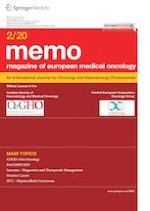03.03.2020 | original report
Different CALR mutation subtypes in essential thrombocythemia and primary myelofibrosis patients without JAK2 mutation
Erschienen in: memo - Magazine of European Medical Oncology | Ausgabe 2/2020
Einloggen, um Zugang zu erhaltenSummary
Background
Discovery of calreticulin (CALR) mutations are considered essential in understanding the molecular basis of myeloproliferative neoplasms (MPNs). These mutations have been demonstrated to be the second driver mutation in MPNs especially essential thrombocythemia (ET) and primary myelofibrosis (PMF). The diagnostic and prognostic significance of these mutations, in addition to the geographical and ethnic heterogeneity, were previously reported. Molecular profiling also guides the selection of therapy for patients with MPNs. Therefore, we investigated the frequency and clinical and demographic characteristics of CALR mutations in Egyptian patients with MPNs.
Methods
We investigated CALR mutations in 84 Egyptian patients with MPNs using florescent polymerase chain reaction followed by fragment analysis. Then, we analyzed the relationship between the mutations and patient clinical data.
Results
The frequency of CALR mutations was 13% (type 2 mutations, 55%; mix or complex mutations, 27%; type 1 mutations, 18%). CALR mutations were most frequent in ET (21.4%), followed by PMF (15.4%) and were not found in polycythemia vera (PV). Clinically, patients with mutated CALR had significantly lower levels of leukocytes (P = 0.042) and higher platelet count (P = 0.04) compared to those with nonmutated CALR and lower risk of thrombosis although a statistical difference was not detected.
Conclusions
CALR mutations were found frequently in Egyptian MPNs patients with ET and PMF especially in those without JAK2 mutation. Patients with type 2 and complex mutations were more frequent in our cohort than the previously known published data. Thus, CALR is a potentially valuable marker for stratification of JAK2-negative MPN patients.
Anzeige
